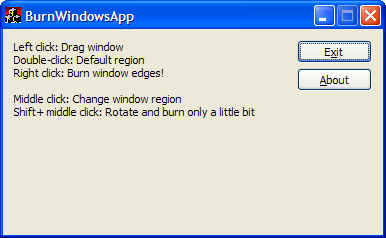Contents
Introduction
Are you tired of shiny, spotless windows? Tired of all that futuristic glass? Would you rather your windows
have that classic, aged, slightly-burned-around-the-edges look of old historic documents? You know, the kind that
just might have a map to buried treasure written on the back? Well, the answer is here! Through the wonders of
modern technology, you can go from this:

or even (gasp), this:

to... (drum roll please) this:

Nicolas Cage will be plotting to steal your windows in no time.
Now you've seen what can be done by burning the edges of a plain old rectangular window. Even more amazing results
can be had by starting with an oddly-shaped window region. Take, for example, this totally boring window:

Yawn. But after just a few applications of the patented* window-burning coding-technologies, you'll arrive at
this wondrous image:

WMP 9 would be envious if it weren't end-of-lifed.
*not actually patented
Tell Me More. C'mon, Man. Spill It. How's It Done?
Every few years, a long-dormant technique is rediscovered and put to use by Microsoft Scientists. In Windows
95, it was owner-drawn menus. In Windows 98, it was FlashWindow(). In Windows XP, it was window regions.
These advances even outpace our need to learn new SI prefixes as our hard drives get bigger (hot tip that'll impress
the ladies: after tera- comes peta-).
Now, in the year two thousand o' eight, I have discovered...
Rotating a Region
The ExtCreateRegion() API can summon a region using nary a RGNDATA blob. Where the
magic comes in is the XFORM parameter. Dust your code with the appropriately-cultivated XFORM
spell component, and ExtCreateRegion() will also rotate the region.
For example, starting with an original region rgn, we can create a copy that is rotated 30 degrees
with this incantation:
int degrees = 30;
float radians = degrees * 2.0f * 3.14159f / 360.0f;
XFORM xform = { cosf(radians), sinf(radians),
-sinf(radians), cos(radians) };
RGNDATA* pData;
UINT cby;
CRgnHandle rgn = ;
CRgn newRgn;
cby = rgn.GetRegionData ( NULL, 0 );
pData = (RGNDATA*) new BYTE[cby];
rgn.GetRegionData ( pData, cby );
newRgn.CreateFromData ( &xform, cby, pData );
delete[] (BYTE*) pData;
The members of XFORM are outlined in the Tome
of the Network of the Microsoft Developer. When using XFORM to perform a rotation, as we are,
the first four members are set as follows:
eM11: cosine of the rotation angle
eM12: sine of the rotation angle
eM21: negative of the sine of the rotation angle
eM22: cosine of the rotation angle
To achieve burnination, simply apply a rotation to your window region repeatedly, as often as desired. Let the
round-off errors do the rest!
Conclusion
Happy 92nd day of the year! (or 91st in non-leap years!)
